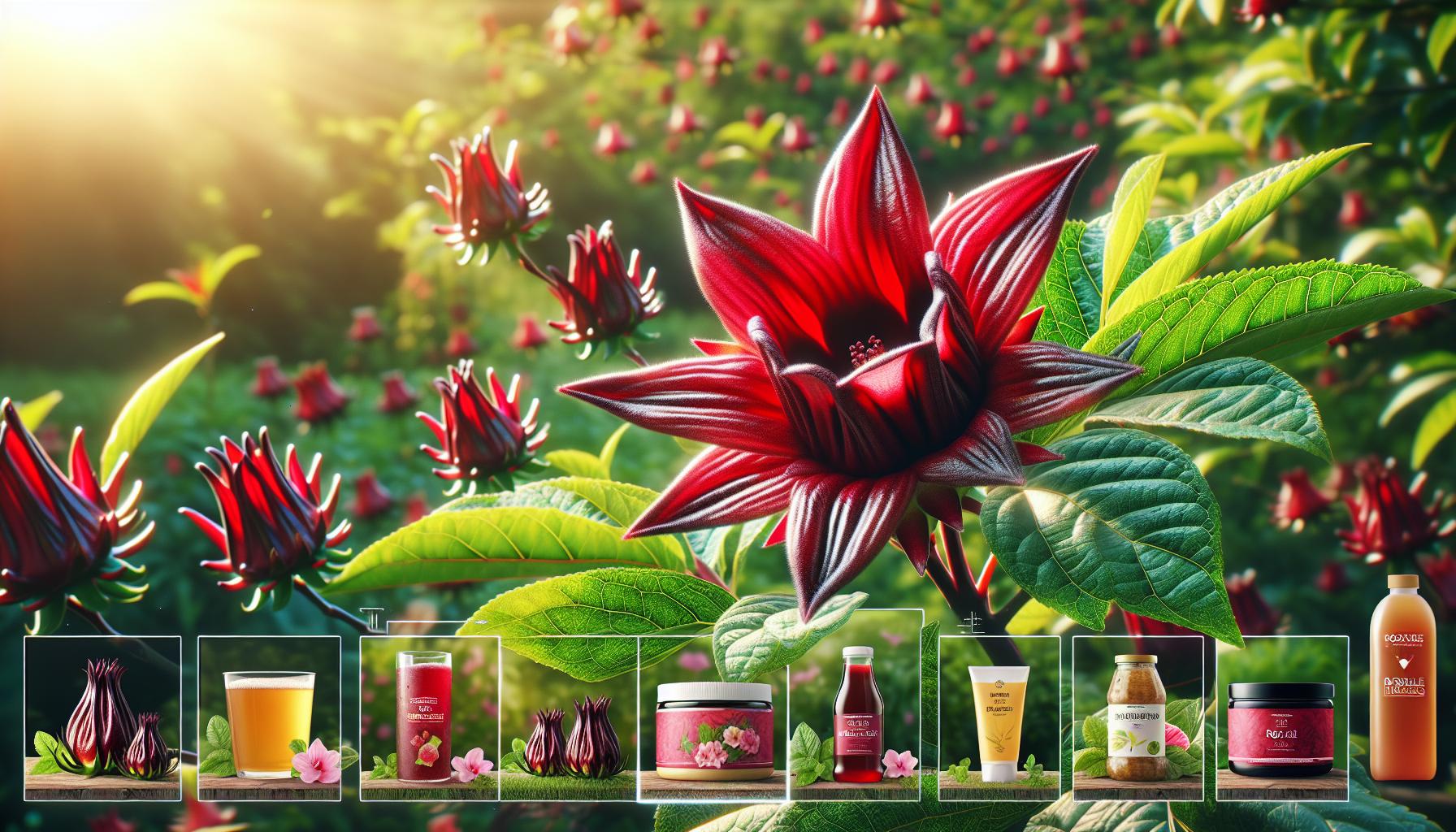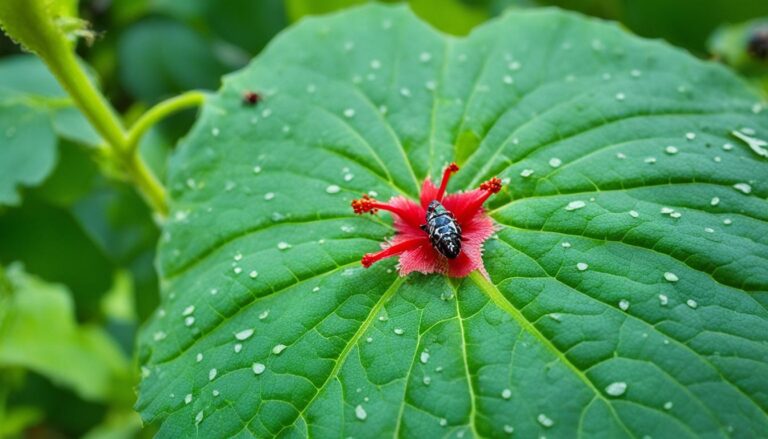Roselle Hibiscus: Health Benefits, Growing Tips, and Versatile Uses in Food and Wellness
Have you ever tasted the tangy, refreshing flavor of roselle hibiscus? This vibrant, ruby-red flower has captured my attention and taste buds alike. As a passionate plant enthusiast, I’ve discovered that roselle hibiscus isn’t just a pretty face – it’s a powerhouse of nutrition and versatility.
Native to West Africa, roselle hibiscus has made its way into cuisines and traditional medicine practices worldwide. But what makes this plant so special? From its use in teas and jams to its potential health benefits, there’s more to roselle hibiscus than meets the eye. Join me as we explore the fascinating world of this remarkable plant and uncover its secrets.
What Is Roselle Hibiscus?
Roselle hibiscus (Hibiscus sabdariffa) is a tropical plant known for its vibrant red calyces and tart flavor. It’s a versatile crop with culinary, medicinal, and ornamental uses.
Origin and Botanical Classification
Roselle hibiscus originates from West Africa, where it’s been cultivated for centuries. It belongs to the Malvaceae family, which includes other well-known plants like cotton and okra. This species thrives in tropical and subtropical climates, growing as an annual or short-lived perennial.
Physical Characteristics
Roselle hibiscus plants are striking in appearance:
- Height: 3-8 feet tall
- Leaves: Dark green, deeply lobed, 3-5 inches long
- Flowers: Pale yellow with a dark red center, 3-4 inches in diameter
- Calyces: Fleshy, bright red, 1-2 inches long
The plant’s most distinctive feature is its calyces, which envelop the seed pods after flowering. These calyces are the primary harvest for culinary and medicinal uses.
Key growth factors:
| Factor | Requirement |
|---|---|
| Sunlight | Full sun (6-8 hours daily) |
| Soil pH | 6.0-6.8 |
| Water | Moderate, consistent moisture |
| Temperature | 60-80°F (15-27°C) |
I’ve found roselle hibiscus to be a rewarding addition to gardens, offering both visual appeal and practical benefits. Its rapid growth and vibrant colors make it an excellent choice for gardeners looking to add a tropical flair to their landscape.
Health Benefits of Roselle Hibiscus
Roselle hibiscus offers a range of health benefits due to its rich nutritional profile and bioactive compounds. Here’s a closer look at some of its potential health advantages:
Antioxidant Properties
Roselle hibiscus is packed with powerful antioxidants, primarily anthocyanins and flavonoids. These compounds help:
- Neutralize harmful free radicals in the body
- Reduce oxidative stress
- Support overall cellular health
- Potentially slow down aging processes
I’ve found that incorporating roselle hibiscus tea into my daily routine has been a delightful way to boost my antioxidant intake.
Heart Health Support
Roselle hibiscus shows promise in supporting cardiovascular health:
- May help lower blood pressure
- Could reduce bad cholesterol levels
- Supports healthy blood flow
Studies suggest that regular consumption of roselle hibiscus tea may contribute to improved heart health markers. However, it’s essential to consult with a healthcare professional before using it as a supplement for any heart-related conditions.
Potential Weight Management Aid
Roselle hibiscus might assist in weight management efforts:
- Contains enzymes that may aid in fat breakdown
- Low in calories, making it a healthy beverage choice
- May help reduce appetite and food intake
While not a magic solution for weight loss, incorporating roselle hibiscus into a balanced diet and exercise regimen could provide additional support for weight management goals. As with any dietary changes, it’s best to approach this gradually and in consultation with a nutritionist or healthcare provider.
Culinary Uses of Roselle Hibiscus
Roselle hibiscus offers a versatile range of culinary applications, adding a unique tangy flavor and vibrant color to various dishes and beverages. Its edible parts, including the calyces, leaves, and seeds, contribute to diverse culinary traditions worldwide.
Traditional Beverages
Roselle hibiscus is a popular ingredient in traditional beverages across many cultures:
- Sorrel drink: A Caribbean Christmas staple made by steeping dried roselle calyces with spices like ginger and cinnamon
- Agua de Jamaica: A refreshing Mexican iced tea infused with roselle and sweetened to taste
- Karkade: An Egyptian hot or cold beverage made from steeped roselle calyces, often served during Ramadan
- Bissap: A West African drink made from roselle, sometimes flavored with mint or other herbs
To prepare a basic roselle tea:
- Boil 4 cups of water
- Add 2 tablespoons of dried roselle calyces
- Simmer for 10 minutes
- Strain and sweeten to taste
- Serve hot or over ice
Culinary Applications in Various Cuisines
Roselle hibiscus finds its way into diverse culinary applications:
- Jams and preserves:
- The pectin-rich calyces make excellent jams and jellies
- Pairs well with other fruits like strawberries or raspberries
- Sauces and chutneys:
- Adds a tart flavor to savory dishes
- Complements meats like pork or duck
- Salads:
- Fresh calyces provide a crunchy, tangy addition to green salads
- Young leaves can be used as a spinach substitute
- Baked goods:
- Dried and ground calyces add color and flavor to cakes, cookies, and breads
- Use as a natural food coloring for frostings and glazes
- Soups and stews:
- Common in Middle Eastern and African cuisines
- Adds acidity and depth to hearty dishes
- Garnishes:
- Fresh or candied calyces make attractive garnishes for desserts and cocktails
Roselle hibiscus culinary uses table:
| Part Used | Culinary Application | Example Dish |
|---|---|---|
| Calyces | Beverages, jams | Sorrel drink, hibiscus jelly |
| Leaves | Salads, stir-fries | Hibiscus leaf salad |
| Seeds | Roasted, ground | Spice blends, coffee substitute |
| Flowers | Garnish, tea | Hibiscus iced tea |
Incorporating roselle hibiscus into your cooking adds a unique flavor profile and nutritional benefits to your meals. Experiment with different parts of the plant to discover new and exciting culinary possibilities.
Growing Roselle Hibiscus
Roselle hibiscus thrives in specific conditions and requires careful cultivation. Here’s what you need to know about growing this versatile plant.
Ideal Climate and Conditions
Roselle hibiscus loves warmth and sunlight. It grows best in:
- USDA hardiness zones 8-11
- Full sun exposure (6-8 hours daily)
- Well-draining, fertile soil with pH 6.0-6.8
- Temperatures between 60-80°F (15-27°C)
I’ve found that roselle plants are surprisingly resilient to heat, but they can’t tolerate frost. In cooler regions, grow them as annuals or in containers that can be moved indoors during winter.
To boost growth:
- Space plants 3-4 feet apart
- Provide consistent moisture
- Apply balanced, organic fertilizer monthly
Cultivation and Harvesting
Growing roselle hibiscus is straightforward if you follow these steps:
- Start seeds indoors 4-6 weeks before the last frost date
- Transplant seedlings outdoors after danger of frost has passed
- Pinch off early flower buds to encourage bushier growth
- Harvest calyces 2-3 weeks after flowering, when they’re plump and bright red
| Growth Stage | Time Frame |
|---|---|
| Seed to Seedling | 7-14 days |
| Transplant to Flowering | 3-4 months |
| Flowering to Harvest | 2-3 weeks |
For optimal yield:
- Prune plants regularly to maintain shape and encourage branching
- Watch for pests like aphids and whiteflies; treat with neem oil if necessary
- Harvest leaves throughout the growing season for fresh use
Remember, patience is key with roselle hibiscus. It’s a slow starter, but once established, it’ll reward you with abundant harvests. The bright red calyces are ready for picking when they’re firm and easily snap off the plant.
Potential Side Effects and Precautions
While roselle hibiscus offers numerous health benefits, it’s important to be aware of potential side effects and take necessary precautions. Here’s what you need to know:
- Blood pressure concerns:
- Roselle can significantly lower blood pressure
- Caution advised for those with hypotension or on blood pressure medication
- Monitor blood pressure regularly if consuming roselle regularly
- Pregnancy and breastfeeding:
- Avoid roselle during pregnancy due to potential uterine contractions
- Limited research on effects during breastfeeding; consult a healthcare provider
- Drug interactions:
- May interact with certain medications, including:
- Diuretics
- Diabetes medications
- Blood thinners
- Always consult your doctor before consuming roselle if you’re on medication
- Allergic reactions:
- Rare, but possible
- Symptoms may include:
- Skin rash
- Itching
- Difficulty breathing
- Discontinue use and seek medical attention if allergic symptoms occur
- Digestive issues:
- Large amounts may cause:
- Stomach upset
- Diarrhea
- Gas
- Start with small amounts and gradually increase intake
- Liver concerns:
- Some studies suggest potential liver toxicity with excessive consumption
- Moderation is key; follow recommended dosages
- Dental health:
- High acidity may erode tooth enamel
- Rinse mouth after consuming roselle tea or products
- Blood sugar effects:
- May lower blood sugar levels
- Diabetics should monitor blood glucose closely when consuming roselle
Remember, while roselle hibiscus is generally safe for most people, it’s always best to consult with a healthcare professional before adding it to your diet, especially if you have pre-existing health conditions or are taking medications.
Roselle Hibiscus in Commercial Products
Roselle hibiscus has gained popularity in various commercial products due to its unique flavor and potential health benefits. Its versatility extends beyond home gardens to a wide range of consumer goods.
Teas and Beverages
Roselle hibiscus is a key ingredient in many popular teas and beverages. Its tart, cranberry-like flavor adds a refreshing twist to hot and cold drinks. Here’s how it’s used:
- Herbal teas: Dried roselle calyxes are often blended with other herbs for flavorful, caffeine-free infusions.
- Iced teas: Commercial brands use roselle to create vibrant, ruby-red iced teas with a tangy taste.
- Cocktail mixers: Bartenders incorporate roselle syrup or extract in cocktails for a unique flavor profile.
- Fruit juices: Some manufacturers add roselle to fruit juice blends for added tartness and color.
- Kombucha: Craft kombucha brewers use roselle as a flavoring agent in their fermented tea drinks.
Supplements and Extracts
The potential health benefits of roselle hibiscus have led to its inclusion in various supplements and extracts:
- Capsules: Concentrated roselle extract is available in capsule form for those seeking its antioxidant properties.
- Liquid extracts: Tinctures and liquid concentrates offer a convenient way to add roselle to beverages or foods.
- Powders: Freeze-dried roselle powder is used in smoothies, baking, or as a natural food coloring.
- Skincare products: Some cosmetic companies incorporate roselle extract in anti-aging creams and serums.
- Nutraceuticals: Roselle is sometimes combined with other botanicals in health supplements targeting specific conditions.
These commercial applications showcase roselle’s versatility beyond the garden. Its unique properties make it a valuable ingredient in both the food and wellness industries.
Conclusion
Roselle hibiscus stands out as a remarkable plant with a wide range of applications. From its vibrant flowers to its health-boosting properties, it’s no wonder this versatile herb has gained popularity in various industries. I’ve explored its cultivation, benefits, and potential risks, highlighting its significance in both traditional and modern contexts. As with any natural remedy, I recommend consulting a healthcare professional before incorporating roselle hibiscus into your routine. Whether you’re sipping on a refreshing tea or exploring its skincare benefits, this incredible plant offers a world of possibilities for health-conscious individuals and culinary enthusiasts alike.







